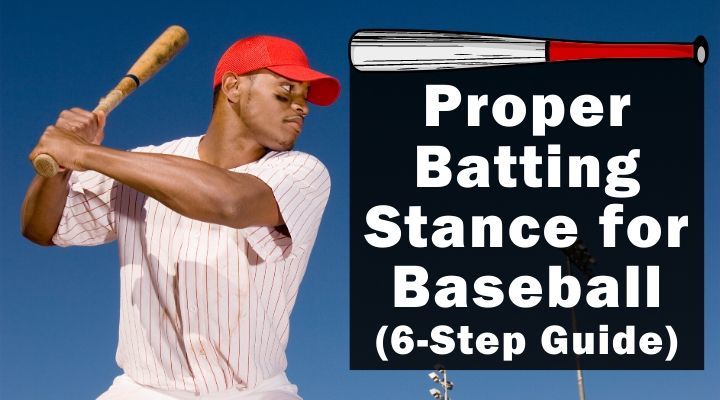All good baseball hitters first learn the proper batting stance.
No matter how strong you are, how quick your hands are, and how good of an "eye" you have for the game...
You won't be a consistently effective hitter if you don't start with the proper batting stance.
If you watch a Major League Baseball game, you're probably going to see plenty of different batting stances, though.
So, why’s that? And which one is the proper one?
In reality, there are many different variations of a batting stance, with each batter making a slight adjustment here or there to get a stance that's comfortable for him.
Some of these stances may be open, closed, or even.
Some batters may stand straight up or crouch lower to the ground.
While these stances can look quite different from one another, they all work because they follow all the basic principles of a proper batting stance.
Let's take a look at how you can get a proper batting stance for baseball in six steps.

Proper Batting Stance in 6 Steps
Step #1: Get Your Feet Set
Once you enter the batter's box, the first thing you'll want to do is get your feet properly set.
You do this by aligning your feet up with your shoulders, imagining that a straight line is running in between them.
Next, place your front foot roughly five to seven inches forward, toward the pitcher.
By setting your feet up this distance apart, you'll be ensuring that you can maintain good balance.
Anything too much wider or narrower than this can make it hard to maintain balance through your swing.
Finally, plant your front foot in the ground, and put your weight on your back foot.
This will allow you to get your body behind the swing.
Step #2: Get aligned
Now that your feet are set, make sure you’re lined up with the pitcher.
Do this by pointing your chest and your toes toward the homeplate.
At the same time, hold the bat parallel to the ground and extend your arms.
Stand back from the plate so that the barrel of the bat can cover the entire place when you swing.
How long your bat is will help determine how far back from the plate to stand.
If the bat covers the plate when your arms are extended through your swing, you’re in a good position.
If it doesn't cover the entire plate, or if it covers too much of it, then you'll need to adjust how far off the plate you’re standing.
Step #3: Bend Your Knees
Aside from the spacing between your legs, you maintain balance in your stance by bending your knees.
You don't want to be standing straight up with your legs not bent at all.
At the same time, you don't want to be crouched all the way down as if you were a catcher.
You need to find a nice position somewhere in between the two so that your knees can be bent not too much but not too little and still be comfortable.
Try to limit your movements in the box as well.
While you can sway the bat, tap your toes, or move your body a bit as you await the pitch, you don't want too much movement as it could throw off your timing.
You basically want to remain still in the box as you await the pitch.

Step #4: Get Your Fingers Set
Turning to how you hold the bat, it's important that you have your fingers set properly.
One hand should be aligned above the other hand on the bat, and they should be touching.
The joints on your fingers on the bottom hand should line up perfectly with the knuckles on the top hand.
You should be able to draw a straight line down from the knuckles in the top hand to the joints in the bottom hand.
If you rotate either (or both) of your hands in either direction, this will throw off the fluidity of your swing, and reduce the amount of power you can get.
Step #5: Keep Your Eyes on the Pitcher
When you get your stance set in the batter's box, you'll notice that if you point your head straight and don't turn your neck, you'll be looking straight into one of the dugouts.
The pitcher will be either to your left (if you're right-handed) or to your right (if you're left-handed).
Obviously, this won't work.
Make sure that you have both of your eyes on the pitcher, without turning your entire body toward the mound.
To do this, make sure your head is up straight. Then, turn your chin so that it's tilted in the direction of your front shoulder slightly.
This will allow you to see the pitcher with both eyes and track the ball on its complete path to you - from the pitcher's glove all the way to your bat.
Step #6: Keep Your Hands Up
The final key factor in establishing a proper batting stance is to make sure that you keep your hands up.
With the bat in your hands, make sure that your hands are raised up, but make sure they aren't higher than your shoulders.
You also want to create a straight line with your back elbow to your shoulder so that it's parallel to the ground.
Your hands should be level with your chest, while the bat will be raised back behind your head diagonally.
Common Mistakes Hitters Make
Now that you know how to establish a proper batting stance in baseball, it's a good idea to look at some of the common mistakes that hitters make when in their stance.
This can help you realize what you may be doing wrong if something doesn't feel comfortable or if you’re having trouble making solid contact.
By understanding these most common mistakes, you can correct what you're doing wrong and ensure you have a proper batting stance.
Mistake #1: Not Starting 50-50
This is all about where you place your weight in your stance.
We talked about how you want to shift your weight to your back foot while keeping your front foot planted.
This is true, but you want to make sure that your weight is relatively evenly distributed throughout your body.
If you have too much weight on your back leg, then it’ll be really hard to shift your weight forward in a timely fashion to actually make contact with the ball.
If you have too much weight on your front leg, then it’ll be hard to get a lot of power behind your swing.
Most hitters that make this mistake shift too much weight to their back leg.
The best way to tell if you're doing this is to look at your back knee.
If that back knee is positioned over your back foot, then you know you have shifted your weight to the back too much.
Mistake #2: Having Your Head Behind Your Center
Make sure that your body is aligned from top to bottom in a straight line.
You don't want the top of your body to be too forward or too back from the bottom of your body, as it will throw off your balance.
To see if you're aligning your body properly, you want to make sure your chin, nose, and eyes are aligned with your belly button.
If they're too far behind, then you'll be starting in a bad posture and be "working uphill" when you go to swing.
This will be because your front shoulder will be raised above your back shoulder in most of these cases.
Mistake #3: Picking Your Front Heel Off the Ground
Some hitters may like to start with their front heel off the ground because they think it helps them load up before the pitch comes.
In reality, though, it actually makes it much harder to load properly and throws off your balance quite considerably.
If you pick your front heel off the ground, even ever so slightly, you'll notice that your weight shifts back considerably in your stance.
This isn’t a good thing, as we've talked about before.
That said, if having your front heel lifted off the ground is really the most comfortable position for you, then you'll just need to be aware of this natural weight shift.
In other words, if you want to keep your front heel off the ground slightly, it's OK -- as long as you’re mindful that you'll need to shift some of your weight to the front, off your back leg.
Mistake #4: Standing Too Wide
A lot of batters have trouble establishing the proper distance between their legs when they stand at the plate.
In most cases, they’ll end up standing with their legs too far apart.
If you start with a stance that’s too wide though, it’ll be very difficult for you to stride toward the plate and shift your weight from front to back.
Not only will you be reducing the amount of power that you get behind your swing, you'll also be throwing off your timing.
Make sure that you keep your feet distanced properly, and you'll be able to have that proper weight transfer from the back of your body to the front through your swing.
Mistake #5: Holding the Bat Wrong
The final common mistake is hitters will bat the bat incorrectly.
They may do this by tilting the bat too far one way or by holding their hands too high or too low. Many batters will tilt the bat forward toward the pitcher.
In this instance, the elbow and shoulder of the top hand will be much higher than that of the bottom hand, which will throw off the balance of your upper body.
It'll also create a very long path from the back of the swing to the ball.
Some hitters will hold their hands way too high, well above shoulder height.
This makes it difficult to have a proper "load" on the swing and slows down bat speed as well.
Other hitters will hold their hands too low, below their shoulder height.
This position makes it very difficult to get the proper load on the swing, and also makes it very difficult to "raise up" and hit pitches in the middle-to-upper half of the strike zone.

Conclusion
Any good hitter will start with a proper batting stance.
No matter how skilled a hitter is, if he doesn't have a proper stance that follows the above six basic steps, it’ll be very hard for him to have successful plate appearances.
If you set your stance and find that you're having trouble making contact or feel off-balance, take a look at the five common mistakes hitters make in their stance to see if you're making one (or more of them).
Then, you'll be able to easily make adjustments in your stance to give yourself the best chance at making successful contact.

